Application of Scanning Electron Microscopy and Fourier-Transform Infrared Spectroscopy to Study Surface Design and Chemical Group Components of Merino Wool, Paschmina and Angora Fibers
Gurumurthy BR1* and Ramesh KP2
1Department of Chemical Engineering, Textile and Fashion Technology, Vignans (Deemed to be University), Guntur, India
2Department of Physics, Indian Institute of Science, Bangalore, India
Submission: October 31, 2017; Published: February 22, 2018
*Corresponding author: Gurumurthy BR, Department of Chemical Engineering, Textile and Fashion Technology, Vignans (Deemed to be University), Guntur, India, Email: voguru1@gmail.com
How to cite this article: Gurumurthy BR, Ramesh KP. Application of Scanning Electron Microscopy and Fourier-Transform Infrared Spectroscopy to Study Surface Design and Chemical Group Components of Merino Wool, Paschmina and Angora Fibers. Curr Trends Fashion Technol Textile Eng . 2018; 3(2): 555607. DOI: 10.19080/CTFTTE.2018.03.555607
Abstract
Textile fibrous materials are used for making fashion utility products in day to day use. These fibers find applications in polymer blends, composites, fiber reinforce plastics, bio-medical textiles and many such high end uses. However, fibers like merino wool, pashmina and angora fibers are some of the natural animal fibers which are obtained in nature and find wide applications if converted into usable fashion products. These natural fibers are characterized with specific microstructure which can be tapped to design and create innovative fashion products. The importance of understanding these surface and micro-structures helps in designing and engineering a particular fashion product in textile science and engineering. In this study we look into the finer detail application of SEM used to characterize the surface, inter surface and other dynamic properties of these fibers. Scanning electron microscope has the capability to image these fiber surfaces at different magnifications which thus facilitates the observations to be examined at varying conditions of usage. These SEM images also gives insight into the steps that can be used to manipulate the process and product development steps used for textile materials. On the other hand spectral analysis using Infra-red spectroscopy gives broad information on the qualitative and quantitative analysis of these fibers. FTIR helps in elucidation and identification of chemical groups and interfer structure property relationship of these natural fibers which are obtained from animal source.
Keywords: Scanning electron microscope; Textile fibers; Infra-red spectroscopy; Merinowool; Pashmina; Angora
Introduction
Wool is one of the protein fibers which find its application in many fashion products. Wool has excellent heat retention and moisture absorbance properties. Apart from this, other fibers like angora and pashmina do possess similar properties of wool fiber but outperform wool in terms of its surface properties. However, angora fibers are finer than wool and are used in making high quality yarns for hosiery and knitting garments. Pashmina is one of the well-known highest grade of animal fibers. Pashmina provides excellent warmth characteristics and is used to make clothing which is used in frigid conditions. Scanning electron microscopy is one of microscopy techniques used for investigation surface and morphological structure of fibers. Scanning electron micrographs [1], when coupled with digital imaging techniques will be able to give quantitative values of cuticle scale parameters like scale height, scale length, scale edge angle. Qualitative study and molecular structure analysis using Fourier transform infrared transmission spectra gives complete information on the presence of functional groups and its contribution to fiber properties. Quantitative study using Fourier transform infrared absorbance spectra data [2], throws light on the amount of light absorbed by the molecules present in the fiber. In this study field emission scanning electron microscopy is used for capturing the micrographs at different magnification for merino wool, angora and pashmina fibres. Perkin Elmer Fourier transform infra-red spectra are used for qualitative and quantitative analysis of these which include molecular structure and distribution of functional groups in protein fibres used in this study [3].
Experimental
Materials
In this study animal fibers like merino wool, angora and pashmina fibers were obtained from known sources. Images of samples of fibers used in this study are shown in Figure 1. Conditioning of the samples was carried out before subjecting them to testing on Scanning electron microscope and FTIR spectrometry to analyze their structural composition and characterization. Table 1 shows the list of fibers used in this study Merino wool (Figure 1) is a keratin based biopolymer which finds extensive application in fashion and apparel products. The molecular structure of wool fiber is composed of di-sulphide bonds which connects the peptide chains [4]. Merino wool is one of the protein fibers which possess excellent moisture and temperature regulation properties. The primary structure of wool is composed of 20 amino acids and secondary structure occurs when the sequence of amino acids are linked to hydrogen bonds. The regular configurations of protein macromolecules generally exist in three types like the alpha helix, secondly the beta pleated sheet and beta turn. The principle structural units in the native wool fiber are successive turns of the alpha helix. The intrinsic stability of the alpha helix, and thus the fiber results from intra molecular hydrogen bonds. The presence of disulphide bridges, H-bonds, electrovalent bonds, etc, in wool fibres form the hindrance to the movement of the molecular segments and thus to the secondary structure [5].

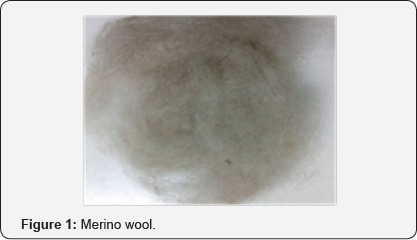
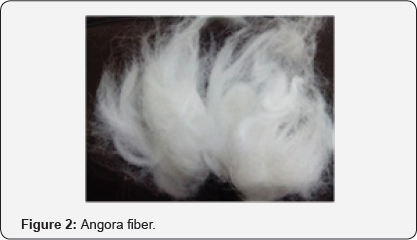
Angora fibers (Figure 2) are a keratin based protein material obtained from Angora goat which is usually long haired. Angora fibers are known for their lightness and outstanding thermal properties. Angora fibers have good potential for producing textiles with special properties. Angora fibers are extremely soft, antistatic, lustrous and durable, while giving high insulation and a warmer feeling to the garments due to its modulated hollow structure in the core. They have high heat retention and best moisture wicking properties of any natural fiber Pashmina wool (Figure 3) is one of the most valued animal fibers. The other name commonly used for pashmina is known as cashmere wool of highest grade category among protein fibers. Pashmina wool is known for its softest, most luxurious and used for making trendiest fashion fabrics. Pashmina wool is obtained from the underbelly of goat indigenous to the Himalayan region [6-8].
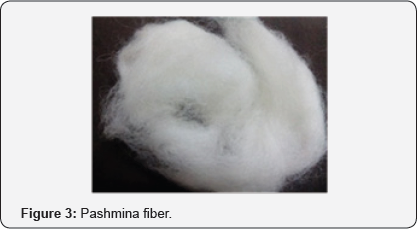
Field emission scanning electron microscope
Ultra 55 FE-SEM (Figure 4) is a general purpose ultra-high- resolution FE-SEM based on the unique GEMINI Technology was used in this study to capture images of fiber samples. Field emissions SEM are combined with analytical capabilities and excellent imaging properties thus making it suitable for a wide range of applications in materials science. Field emission scanning electron microscope work on the principle of electrons liberated from a field emission source and accelerated in a high electrical field gradient. The principle of working of a field emission electron microscope is shown in Figure 4. In this SEM experiment, samples were first prepared on a stub cleaned with acetone carefully to ensure better scanning. The stub was sputtered with gold coating approximately of 10nm for 100 seconds in a sputtering chamber [9]. After this process the samples were mounted on a SEM chamber. Images in this study were captured at a scale of 20|im (varying magnifications) and at high energy potential of 1000KV. The distance between the probe and the sample stub was adjusted at different levels keeping in view the image clarity and its sharpness. The samples were scanned under different magnification levels ranging from 100X to 3000X.
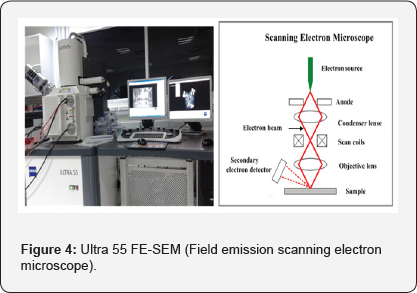
Working principle of FTIR spectroscopy
Infra-red (IR) spectra involve the study of interactions between matter and electromagnetic fields in the IR region. In this spectral region, the EM waves couple with the molecular vibrations. Molecules are excited to a higher vibrational state by absorbing IR radiation. The IR frequency when absorbed would actually interact with the molecule at a certain frequency. Hence, IR spectroscopy is a very powerful technique which provides fingerprint information on the chemical composition of the sample. Using IR Spectroscopy both qualitative as well as quantitative analysis of fiber samples can be carried out. FTIR spectrometry is found to be the most analytical type of techniques available in laboratories. FTIR works on the principle of Fourier transformation (Figure 5). Interferogram is determined experimentally in FTIR spectroscopy. The spectrum is plotted against the corresponding wave number against transmittance values [10-12]. This transformation is carried out automatically and the spectrum is displayed/infrared spectroscopy results in a positive identification (qualitative analysis) and the size of the peaks in the spectrum is a direct indication of the amount of material present. With the modern software, infrared is an excellent tool for quantitative analysis. Fourier Transform Infrared spectroscopy (FTIR) spectra were obtained by means of PerkinElmer Frontier spectrometer (Figure 6) working in the range 350 to 8300cm-1 with a resolution of 0.4cm-1 with a Ge- coated KBr optics and good signal to noise ratio [13].
The untreated samples (fibres) were directly mounted in the sample window and the data were collected with 100 scans per sample. The spectra were named as A, K, P and M for Angora, Kevlar, Pashmina and Merino respectively. Spectra were corrected to the base line blank and then plotted [14].
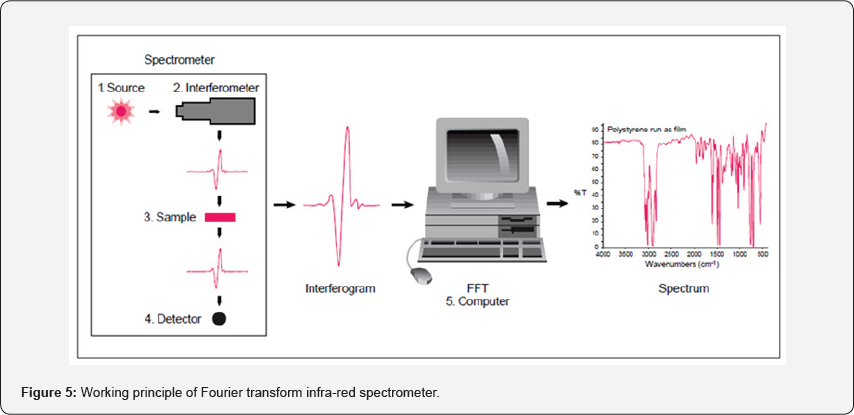
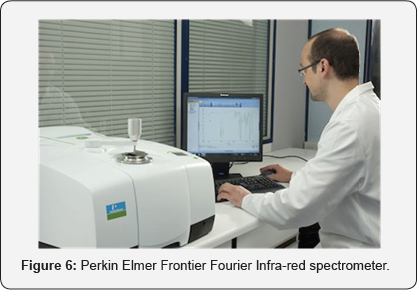
Results and Discussion
Figure 7 & 8 is the SEM micrographs taken on Zeiss field emission scanning electron microscopes at different magnifications of merino wool sample to characterize the surface properties of merino wool fibres. They were taken at 100X, 200X, 300X, 500X, 100KX and 300 KX magnifications. The surface structures of merino wool fibers are composed of scales are very prominently seen in all the images. However, the length of the scale in the fibers varied consistently along the fiber axis. At higher magnifications from 100KX and 500KX the scales were prominently visible. In these images the surface of merino wool fiber scale length is distributed randomly at times evenly spaced and some places merging with the previous scales. This is one of the important observations that image results reveal for merino wool fiber. The height of the scale is not well defined at some points since the scale is not exactly in the shape of a rectangle. The distribution of even scale height would influence the dynamic frictional properties of wool fibers. From the images, observation can be made on the scale frequency which is expressed as the number of cuticle scales in a 100micron field of view normally known as mean scale frequency. The scale frequency is found to be more uniform in case of image taken at 10|im and 300 magnifications. A lower mean scale frequency indicates a longer cuticle scale and a higher mean scale frequency indicates a series of shorter scales. The images of scale edges reveal that they form an obtuse angle and are arranged haphazardly which contributes to uneven locking of fibers at different spots on the fiber surface. A very precise way to measure the scale height, scale length and scale edge angle is to subject the images to digital imaging software [15].
Figure 9 & 10 are Imaging results of Scanning electron microscope on pashmina fiber. The images were taken at different magnification levels. However, the scales are clearly observed on the surface of the fiber only at 300KX magnification. In the images, the scale height is more as compared to merino wool fiber. The scales are longer, showing more curvature at the edges. The variation in scale height is more visible from the SEM images. The length of the scale is more as compared to merino wool fiber [16].
Figure 11 & 12 are scanning electron micrographs of angora fibers which are characterized with high luster. The images were captured at different magnifications. These SEM images of angora fibers reveal detail information on variation in scale height, scale length and scale edge angle when compared to merino wool and pashmina fibers. The images prove that fact that angora fibers have relatively large surface cuticle scales and low cuticle edge height relative to merino and pashmina fibers. The scales of angora fibers are more regular and prominently visible in the micrographs obtained through SEM. The scales are closely overlapped thus resulting in distribution of more uniform curvature on the fiber surface.
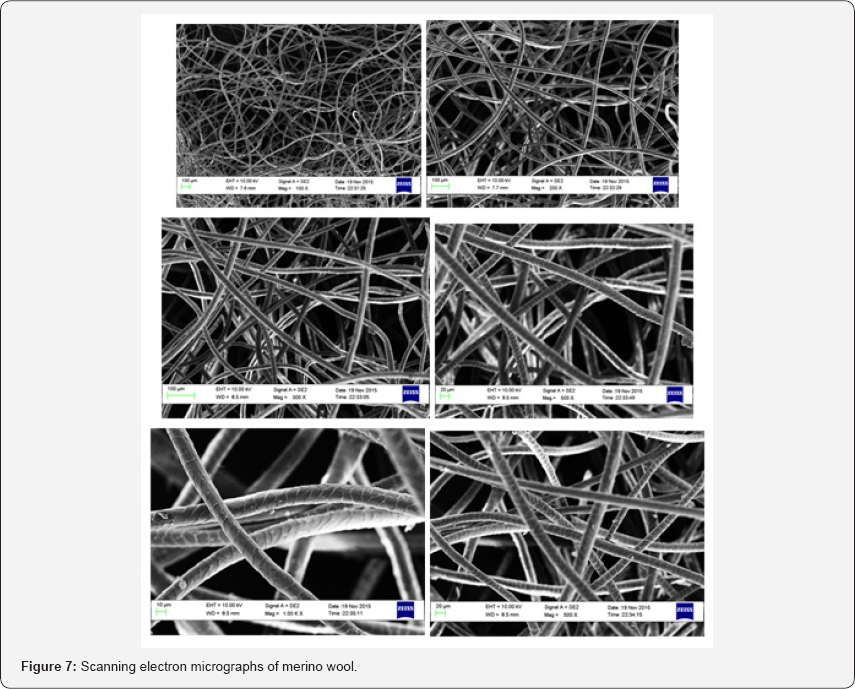
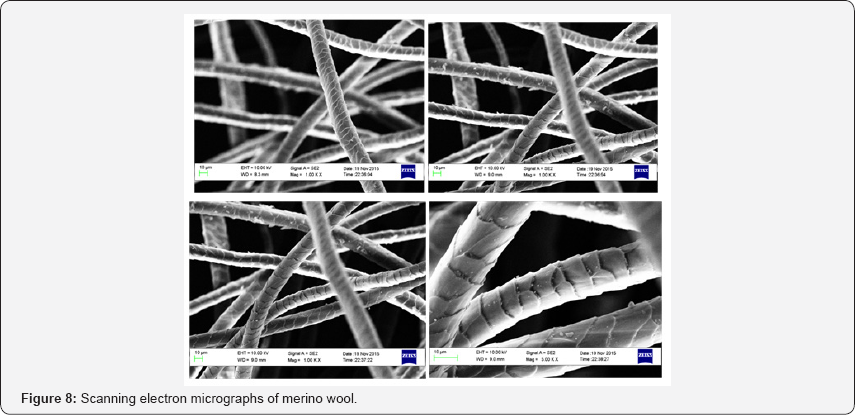
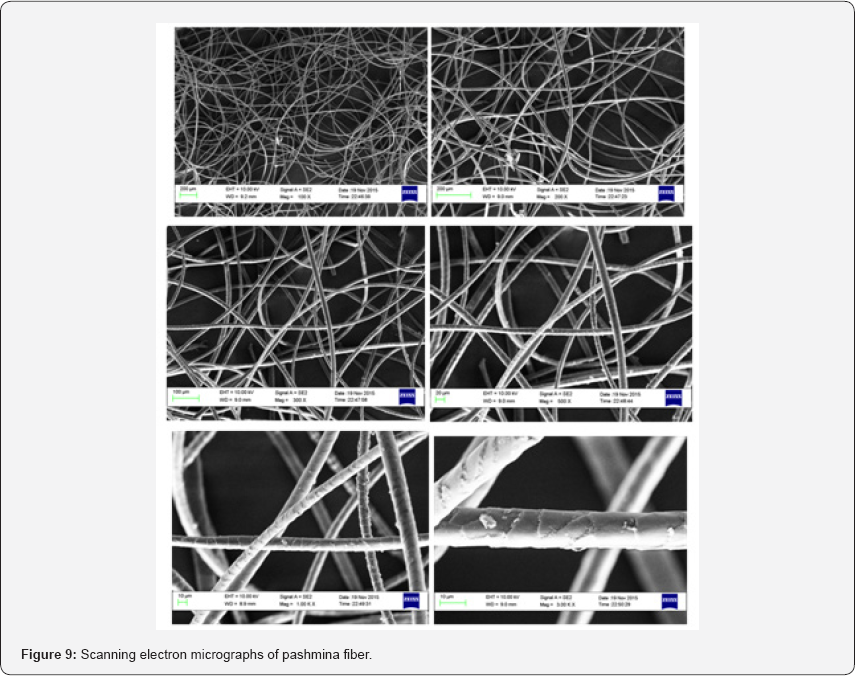
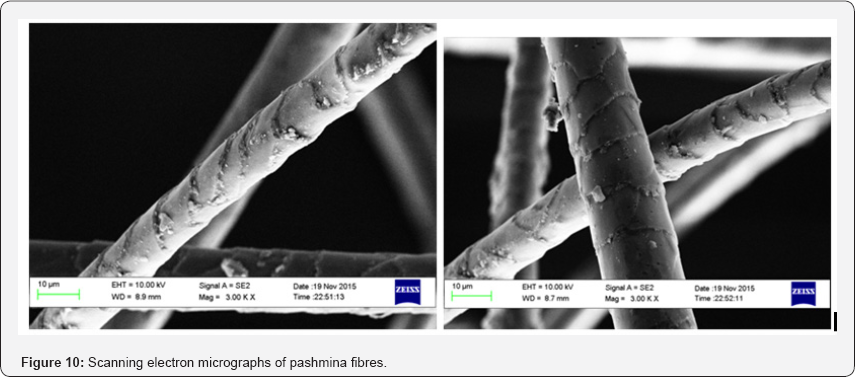
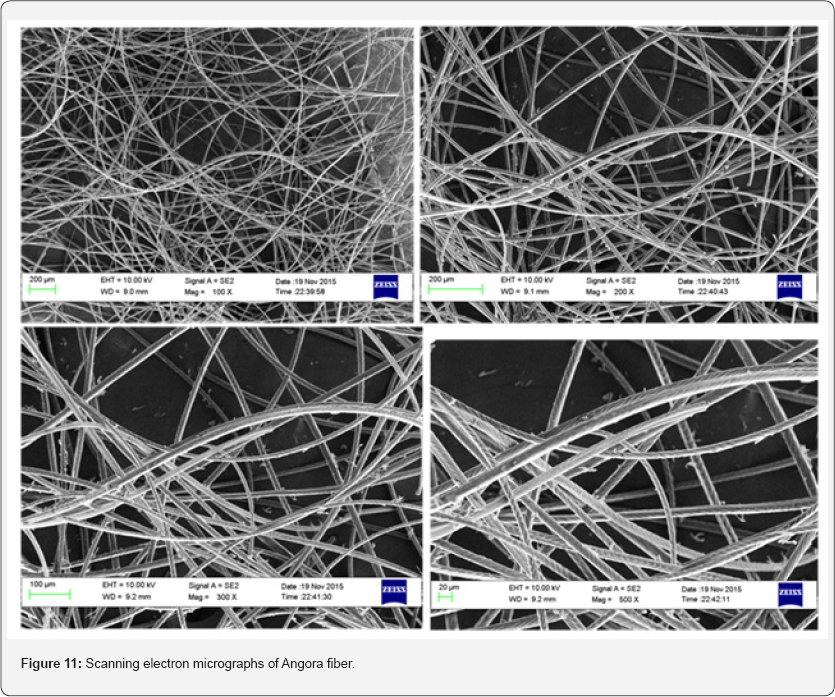
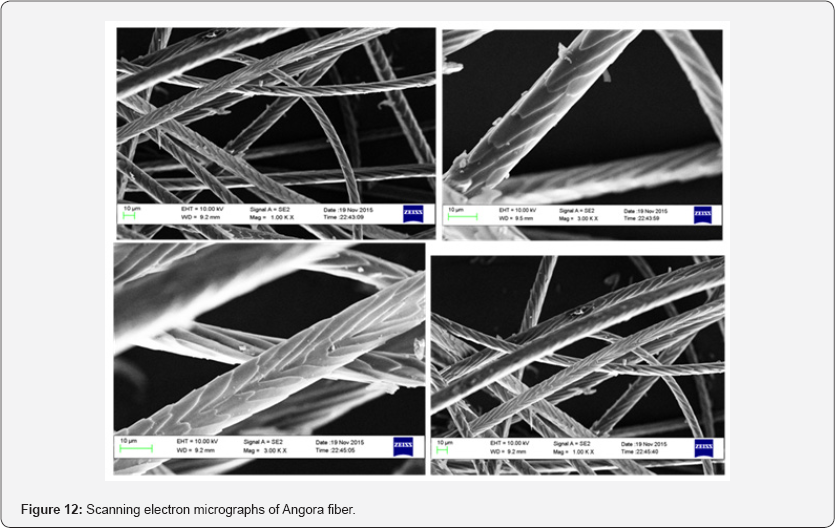
Effect of scales on felting property
The scaliness of the wool fibre is partly responsible for felting phenomena which is one of the dynamic properties of these fibres under discussion. The presence of scales exhibits a higher friction as compared to the smooth surface due to scales or any other crimps on the fiber surface. Merino wool does not contain exceptional property (lustre) that is found like in angora, hence it is found to be dull. The longer and fewer scales on the surface of these fibers result in having a smooth surface. However, the surface is rough if the scales are more and short, arranged very close to each other. The longer the distance between these scales result in more shiny and lustrous fiber.
FTIR results
Results of FTIR spectra for different fibers used in this study in the form of spectra are Figure 13-17. The Spectra in the range 600-4000cm-1 showed clearly dominant peaks around 1510 and 1600cm-1. The band observed at 1635cm-1 is assigned to the broad OH bending modes due to bound water. The band around 1590cm-1 is assigned to the hydrogen bonded carbonyl stretching and O-C-O stretching of carbonate ion [12].
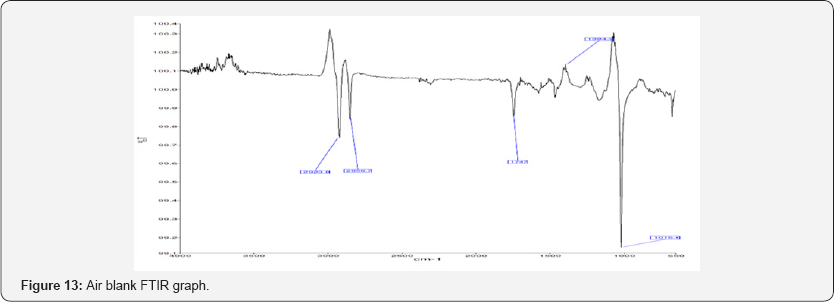
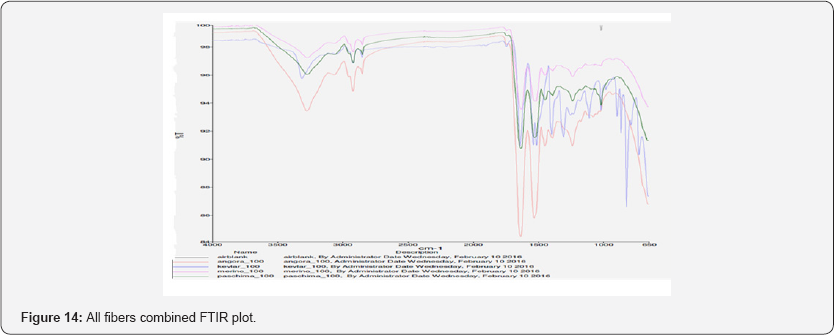
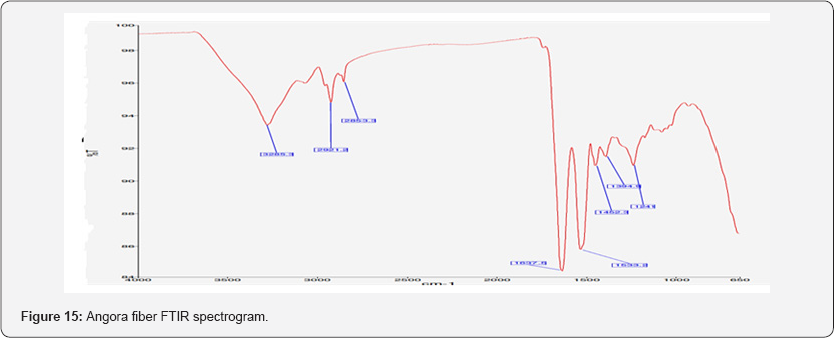
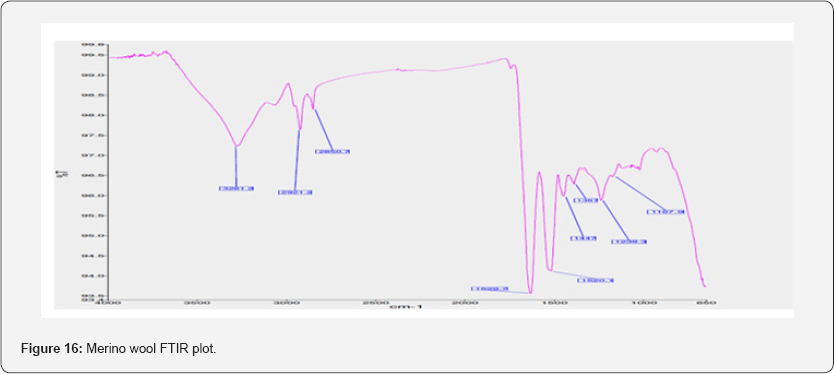
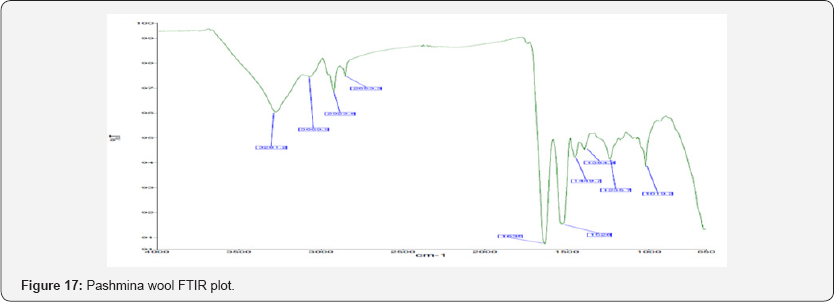
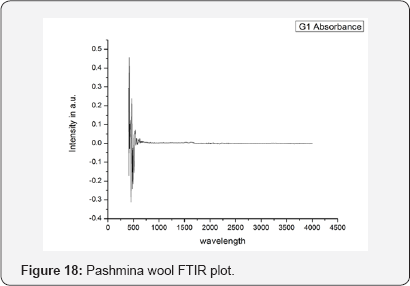
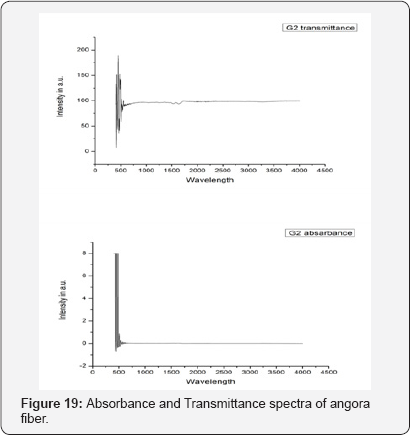
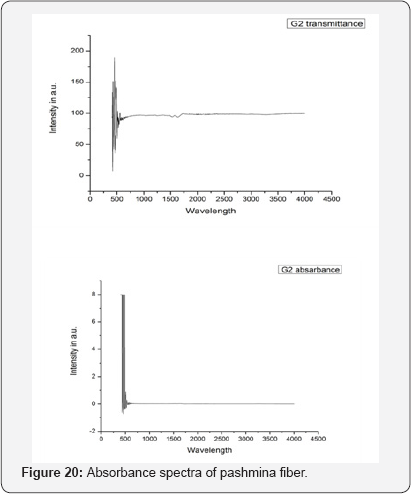
The results of the observations of peaks in spectra are shown in Table 2-4 for merino wool, angora and pashmina fibers. The spectra of the fibers plotted give a qualitative analysis of the presence of functional groups which are identified with specific wavelengths [7]. However the quantitative values of spectra are obtained by plotting absorption values against wavelength for different fibers. The absorption spectra for merino wool, angora and pashmina fibers are shown in Figures 18-20.
The quantitative analysis of the molecular distribution in the fiber structure was explored using absorbance spectra for merino wool, angora and pashmina fibers. The amount of light absorbed indicates the concentration of molecules that absorb the light. The observations were found to be in conformance with Beer- lambert law. For all the fibers the absorbance indicated peaks in the range of 450-800cm-1 substantiating the presence and concentration of more carbon molecules. At this wave number the spectra shows a significant difference when compared at other points. The absorbance is found to be weak as the wave number increased for all the fibers [17].
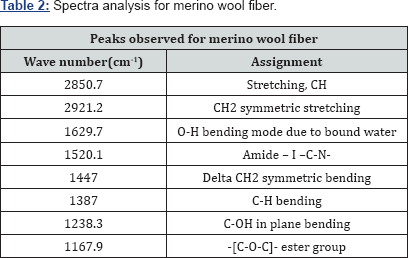
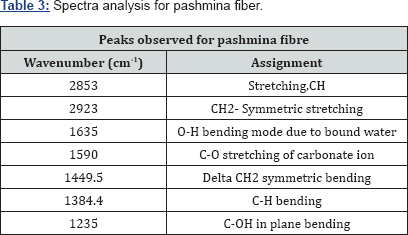
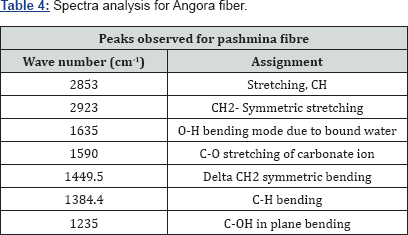
Conclusion
The scanning electron microscopic study on merino wool, angora and pashminas fibers show significant difference in surface structural features. The surface structural features like scale length, frequency, edge height and edge angle are clearly captured using scanning electron microscope which has helped to discuss and understand the effect of scaly surface on dynamic properties like friction and felting properties supporting various theories proposed by eminent researchers. The preliminary characterization runs for merino, angora and pashmina fibers using FTIR spectroscopy throws light on many interesting aspects of molecular structure and composition of these fibers. The peaks corresponding to molecular vibrations have been assigned which is a qualitative output of FTIR technique. The Transmittance and absorbance spectra for these fibers have also been studied into order to make an attempt to quantify the distribution and concentration of functional groups in these fibers. In conclusion, the surface and molecular structure properties of these fibers largely contribute for dynamic properties and overall performance of these fibers when used to make fashion clothing items using these fibers.
Acknowledgment
The Authors wish to acknowledge Dr. Ramesh KP, Associate Professor, Department of Physics, Indian Institute of Science, Bangalore - 12 for providing testing facilities on FTIR study, Nagabhushan Patil, Research scholar, Material research centre, Indian Institute of Science, Bangalore for providing testing facilities of field emission spectrometry, Dinesh Bhatia, research scholar, Department of Textile Technology, National Institute of Technology, Jalandhar for providing fibrous materials for this study. The author also wishes to express thanks to one and all who are involved in this experimental work.
References
- Wortmann FJ, Augustin P (2004) Quantitative fibre mixture analysis by scanning electron microscopy: Part VII: Modelling the microscopic analysis of binary animal fiber blends. Textile Research Journal 74(3): 248-252.
- Carrillo F, Colorn X, Sunol JJ, Saurina J (2004) Structural FTIR analysis and thermal characterization of lyocell and viscose-type fibers. European Polymer Journal 40(9): 2229-2234.
- Agrawal SA, Shaikh TN (2014) Qualitative and Quantitative characterization of textile material by Fourier transform infra-red. International Journal of innovative research in science, engineering and technology 3(1): 8496-8502.
- Bahi A, Jones JT, Carr CM, Ulijin RV, Shdo J (2007) Surface characterization of chemically modified wool. Textile Research Journal 77(12): 937-945.
- Casper C, Stephens JS, Tassi NG, Chase BD, et al. (2004) Controlling surface morphology of electro spun polystyrene fibres: Effect of humidity and molecular weight in the electro spinning process. Macromolecules 37(2): 573-578.
- Colom X, Carrillo Nogues F, Garriga P (2003) Structural analysis of photo degraded wood by means of FTIR spectroscopy. Polymer Degradation and Stability 80(3): 543-549.
- Colom.X, Carrillo, (2002) Crystallinity changes in lyocell and viscose- type fibers by caustic treatment. European Polymer journal 38: 22252230.
- Lee HJ, Yeo SY, Jeong SH (2003) Antibacterial effect of Nano sized silver colloidal solution on textile fabrics. Journal of materials science 38(10): 2199-2204.
- Um IC, Kweon HY, Park YH, Hudson S (2001) Structural characterization and properties of the regenerated silk fibroin prepared from formic acid. Int J Biol Macro 29(2): 91-97.
- Liu JJ, Zou LN, Lv FB, An QB, Liu J, et al. (2015) Application of spectroscopy technology in textiles. International conference of Electrical, Automation and Mechanical Engineering, published by Atlantis Press pp. 482-484.
- Philip Gibson, Heidi Schreuder Gibson, Donald Rivin (2001) Transport properties of porous membranes based on electro spun nanofibers', Colloids and surfaces A: Physicochemical and engineering aspects pp 187-188, 469-481.
- Oh SY, Yoo DI, Shin Y, Seo G (2005) FTIR analysis of cellulose treated with sodium hydroxide and carbon dioxide. Carbohydr Res 340(3): 417-428.
- Tian Genljn, Liu zheng, Xiao Qun Feng, Zhou Xiangqi, Han Xiao Jun, et al. (2010) Structures of natural bamboo fibre for textiles. Textile Research Journal 80(4): 334-343.
- Wortmann FJ, Arns W (1986) Quantitative fibre mixture analysis by scanning electron microscopy, Part I: Blends of mohair and cashmere with sheep's wool. Textile Research Journal 56(7): 442-446.
- Wortmann FJ, Phan KH, Augustin P (2003) Quantitative fiber mixture analysis by scanning electron microscopy: Part VI: Possibility and limitations of the analysis of binary speciality fiber/wool blends in view of test method IWTO-58. Textile Research Journal 73(9): 781-786.
- Wortmann FJ, Phan KH, Augustin P (2003) Quantitative fibre mixture analysis by scanning electron microscopy: Part V: Analyzing pure fibre samples and samples with small admixtures according to test method IWTO-58. Textile Research Journal 73(8): 727-732.
- Wortmann FJ, Gabriele W, Arns W (1989) Quantitative fiber mixture analysis by scanning electron microscopy, Part II: Blends of wool with Angora rabbit hair. Textile Research journal 59(2): 73-80.






























